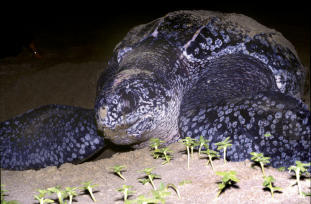 |
 |
 |
 Editorials | Environmental | April 2007 Editorials | Environmental | April 2007  
Newcomers Both Friends and Foes of Mexico's Sea Turtles
 Peggy Grodinsky - Houston Chronicle Peggy Grodinsky - Houston Chronicle


| | The Leatherback is among three turtle species that lay eggs on the beaches near Puerto Vallarta, Mexico. (Peter Richardson/Getty Images) |
Puerto Vallarta — You may not have flippers or a shell, but if you are among the growing number of tourists and expatriates captivated by the beautiful Pacific coastline north of Puerto Vallarta, you do have something in common with sea turtles: a taste for pristine, undeveloped, remote beaches.

Unfortunately, your needs and theirs may collide.

Three species of turtle — the Olive Ridley, Hawksbill and the critically endangered Leatherback — lay their eggs on the contiguous beaches of Litibu, Malinal, Punta Negra and Careyeros, a two-mile stretch of rapidly developing white beach and rock outcrops in the Mexican state of Nayarit.

Two years ago, expatriates living along those beaches began meeting over potlucks to talk about how to protect the natural turtle nursery. They've recently formalized a partnership with the nonprofit Grupo Ecologico Manos Unidas por Litibu A.C (Litibu Ecology Group). With the Mexican government's okay, expertise from biologists and backing from the expatriates, the group operates a turtle corral where the eggs can safely hatch.

"We want to establish the (nonprofit) before the hotels are developed, so that we can have some impact," said Susan Drexler-Price, an organizer of the grassroots homeowners group and former history teacher from Oakland, Calif. (Now, she runs the Pie in the Sky bakeries in nearby Bucerias and Puerto Vallarta.)

Sea turtles face a host of threats around the world. They get tangled up in commercial fishing lines and nets. Pollution makes them sick, literally. Some species are killed for meat, others for their shells.

In Nayarit, poachers steal the eggs for their alleged aphrodisiac effects, gulping them raw with lime and chili. Poached eggs can fetch as much as 10 pesos apiece, says Gilberto Galindo Castro, president of the Litibu Ecology Group and a biologist. At that price, a single nest containing about 100 eggs nets a poacher 1,000 pesos (about $90 U.S.). Compare that, he says, to Mexico's minimum daily wage of 45 pesos. The Mexican government takes poaching seriously, he continued, assessing steep fines or jail time — "it's a worse offense than drugs" — but it lacks the manpower to prevent the crime in the first place or prosecute offenders in the second.

Rapid development endangers the turtles, too. Tourists, and locals for that matter, ride ATVs up and down the beach, potentially crushing the eggs. (Drexler-Price once stopped some riders to try to educate them. "So who are you?" one asked her. "The turtle bitch?" She jokes that she's considered making up T-shirts with the phrase.) Also, lights from mushrooming hotels and homes along the beaches confuse the new hatchlings, which make their way to the ocean by following moonbeams reflecting off the water. The longer it takes them to reach the ocean, the slimmer their chances of ever getting there.

During egg-laying season (June-December), volunteers from the Litibu Ecology Group, many of them university students, carefully move the eggs to the corral, meticulously recording numbers and nest locations. When the eggs hatch, which happens en masse, the newborns scurry across the beach to the sea. Volunteer Jamie Perkins says only one in 1,000 will survive to adulthood. Amazingly, eight to 10 years later, the female turtles return to their natal beach to lay their own eggs.

Efforts in Mexico to protect sea turtles are a patchwork of official and unofficial endeavors, according to Sea Turtle, Inc., a nonprofit based in South Padre Island. In the 1960s, Galindo Castro remembers "mucho, mucho" turtles on this two-mile stretch. (Careyeros, translates as "turtle hunter beach," indicating the turtles have come here, and men have killed them, for quite some time). Then the government said it was okay to harvest them, and their numbers plummeted. When the government changed its mind and changed its policy beginning in 1990, Galindo Castro says the numbers went up again. Since that about-face, SEMARNAT (Mexico's equivalent of our Environmental Protection Agency) has operated a corral in Nuevo Vallarta, about 10 miles from Litibu, last year gathering eggs from some 4,000 turtle nests to better the hatchlings' chances for survival. His own group hopes to relocate eggs from 200 sea turtle nests in the coming season.

There are seven sea turtle species in the world. All are endangered, some, including the leatherback, critically. Why bother to save them?

"Biologists could tell you we don't know exactly what could happen ... if they become extinct, probably something dramatic," Jeff George of Sea Turtle Inc., said during a telephone interview. "We can't tell you exactly how (things) would fall apart, but we know enough about their diet to theorize."

He gave a "for instance." Some sea turtle species eat jellyfish like they are going out of style. If the turtles weren't around to eat the jellyfish, the jellyfish population would explode. The hungry jellyfish hordes, in turn, would gorge on zooplankton. That's bad, very bad, as plankton is vital for healthy seas. Or suppose the sea turtle species that George described as the "lawnmower of the ocean" went extinct. Its dietary habits ensure healthy seagrasses, where it just so happens fish lay eggs and shrimp spawn. Should those turtles disappear, it doesn't look so good for fish or shrimp, either. Or for us.

Sitting at a beachside restaurant not far from the nesting grounds she dreams of protecting, nibbling on chips and sipping a cool drink, Drexler-Price, a layperson, sums up. "Basically," she said, "it's our future."

peggy.grodinsky@chron.com | 
 | |
 |



